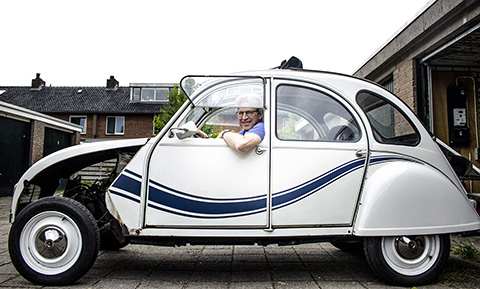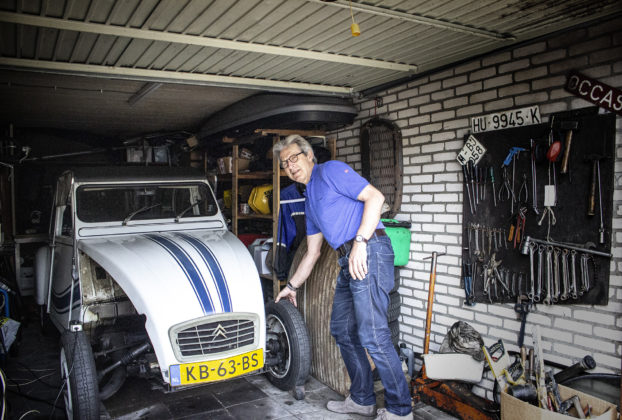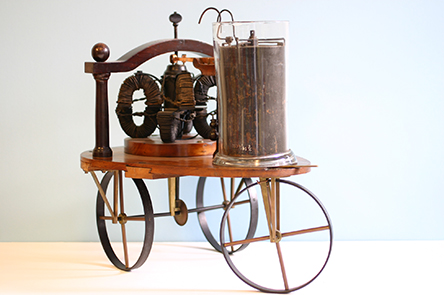
RUG professor turns old car electric
An antique’s second chance at life
He just wanted to show people that it can be done. You can turn an old, polluting petrol car into an environmentally-friendly, working antique. In fact, it’s easy; RUG associate professor Bob de Jonge did it in a rented storage unit. But he wasn’t prepared for all the hate he got.
De Jonge was sick of the noise his old car made. People around him complained of the smell of petrol and he was ashamed of the car’s gross exhaust. After researching his options, he decided to turn his old Citroën 2CV into a modern, electric car. He started a crowdfunding campaign and set up a Facebook page to get some publicity.
Citroën 2CV
- in production from 1949 to 1990
- 5,144,966 cars made in total
- nicknames: Flying Dustbin, Tin Snail, Dolly, Tortoise
- the 2CV museum in Andijk has more than 300 cars
- designed by French farmers
- intended to be economical, simple, and functional
He received a bunch of positive messages and encouragement on his Facebook page ‘BobsECV’. Someone who’d also converted an antique car sent him a picture and some people even sent him money. But mostly what De Jonge received was a lot of hate.
Puking smiley faces
Most of the messages said his actions were pointless, because electric batteries are bad for the environment as well. He’d be better off doing a different project altogether. Others said it was a waste of an antique car. Some weren’t quite as polite as all that, using puking smiley faces and calling him all kinds of nasty names.
‘My first instinct was to get really cynical, like: okay, thanks for your contribution. But I decided against it in the end. I did delete the worst messages.’ He had some trouble deciding where to draw the line, though. He doesn’t want to censor anyone, but the name-calling didn’t add anything to the discussion.
The discussion is important to him, says De Jonge, because what he’s doing isn’t just some hobby. He wants to show the world that it can be done. ‘So that people living in the Amsterdam city centre can still drive their antique cars around town even after diesel cars are no longer allowed.’
He also wants to show people that converting old cars makes sense. He pulls up a chart about CO2 emissions he found in the Volkskrant. ‘Replacing your regular car with an electric car is number 1 on the list of things to do to limit pollution. Replacing your fridge is at the bottom.’
But selling your car that runs on diesel doesn’t solve the problem, says De Jonge: it just makes it someone else’s. ‘Those cars are shipped to Africa and Asia, where they can continue to do damage to the environment.’ He figured he’d try a different attack.
The project isn’t cheap; De Jonge figures it will cost him approximately 25,000 euro. ‘But the more people do it, the cheaper it will eventually become’, he thinks. He started a crowdfunding campaign to help him out, but he’s not expecting much. So far, people have only donated 1,300 euro.
Resistant
De Jonge is surprised how resistant people have been in their responses on his Facebook page. He says people come up with all kinds of reasons to justify not taking any action. They point out other things that are even worse for the environment, claim other actions would do more, and say that De Jonge is a hypocrite. Some people take it pretty far.
According to the RUG, the first electric car was in fact made somewhere around 1835 by RUG professor Sibrandus Stratingh. Other sources credit the Hungarian Anyos Jedlik with inventing an electric car in 1928 or the American Thomas Davenport.
Until the 1920s, electric cars were very popular because they didn’t smell bad, but it was eventually surpassed by the petrol-driven car. With the invention of the lithium battery, most often used for laptops and cell phones, the electric car is back on the market.
‘People even figured out that I fly regularly, to New York and Argentina.’ But that’s for work: he is an assistant professor of Spanish at the RUG. He also goes on vacation to Spain in his Land Rover. ‘People tell me I shouldn’t do that, but I can’t just change my entire life all at once. You have to start somewhere.’
He pushes the car out of the storage unit. In the back, its motor and its petrol tank are laid out on a table. The exhaust hangs from the ceiling above it. All that’s left under the car’s bonnet is the gearbox and the old battery that operates the windshield wipers and the radio. The car has lost about a hundred kilos in weight.
This will be replaced by an electric motor, which will weigh thirty to forty kilos, and a pair of batteries taken from an old Tesla. They are lighter than normal batteries, but together they still weigh around 150 kilos. ‘I hope to find some lighter ones in the future. I might have to replace the suspension with a sturdier one, but I already replaced the chassis once, so that should be able to handle the weight.’
The greatest thing about the 2CV is how simple it is: ‘I renovated it once before and managed to take it apart using nothing but an electric drill and a number 11 socket spanner.’ De Jonge prefers to do everything himself. He demonstrates how the little flap-up windows click into place. ‘Isn’t it ingenious?’
He doesn’t think the conversion is a waste of a classic car? ‘Heck’, he says, ‘it’s fine if we keep a few in a museum, but cars just need to be driven, you know?’
He certainly won’t miss the racket the motor used to make. ‘Every time you got any speed going you’d have to practically shout to hear each other. And you’d have to crank up the radio really loud, too.’ But an electric motor runs quietly, with a gently hum, De. He points to the insulation under the bonnet and around the dashboard. ‘That’s all gonna come out.’
Land Rover
When he’s done, he’ll move on to the Land Rover. His is a more modern version and has soot filters, but it’s still a diesel car and he’s a little ashamed to drive it. ‘We bought it because we vacation to the Spanish mountains and you need a four-wheel drive to get there. But that’s all I use it for. I take the train to work and do all my groceries on my bike.’
He briefly considered trading in the Land Rover for a hybrid car, but was told that wouldn’t make a difference. ‘Only on short drives.’ Since he only drives the car to Spain, that wouldn’t have done much good. And again, it would only pass the diesel motor on to a new owner. Besides: ‘No one wants to buy it. The trade-in value of diesel cars has gone down significantly, while that of electric motors has gone up.’ Best to just convert the whole car.
But first he has to finish the 2CV. The car is due for inspection in the autumn of 2020. ‘So I’ve got eighteen months.’



